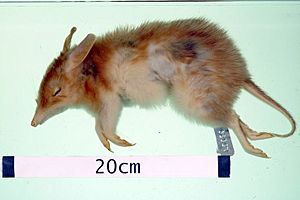Desert bandicoot facts for kids
Quick facts for kids Desert bandicoot |
|
|---|---|
 |
|
| Taxidermied specimen | |
| Conservation status | |
| Scientific classification |
The desert bandicoot (Perameles eremiana) was a small marsupial that used to live in the dry, central parts of Australia. Sadly, it is now extinct, meaning there are no more desert bandicoots left in the world.
Contents
Discovering the Desert Bandicoot
The desert bandicoot was first officially described by a scientist named Walter Baldwin Spencer in 1897. He studied a specimen, which is a preserved example of an animal, that was sent to him by a person named Mr. Gillen from Alice Springs. This important specimen was then kept at the National Museum in Melbourne.
Scientists weren't always sure if the desert bandicoot was its own unique species or just a type of another bandicoot. However, a study in 2012 confirmed that it was indeed a distinct species.
Indigenous peoples of central Australia had their own names for this animal. At Alice Springs, they called it mulgaruquirra, and at Charlotte Waters, it was known as iwurra. Other common names for the desert bandicoot included the orange-backed bandicoot and waliya, which came from the Warburton region.
What Did the Desert Bandicoot Look Like?
The desert bandicoot was a type of Perameles, a group of bandicoots that lived on the ground. Like other bandicoots, it used its short front legs to dig in the dirt. Its back legs looked a bit like those of kangaroos and wallabys. It also had a special feature called syndactyly, where its second and third toes on its back feet were joined together.
This bandicoot had a small body and a long, narrow, pointed head. This shape was perfect for poking into the sand while it dug for food. Its fur was coarse and stiff. The desert bandicoot was a dull orange color with darker bands across its back.
It looked a lot like the western barred bandicoot. You could tell the desert bandicoot apart by its reddish-orange fur on its sides, face, and back. Its feet, both front and back, were covered in dark brown fur. The tail of the desert bandicoot was relatively long, measuring about 7.7 to 13.5 centimeters. The top of its tail was dark brown and tapered to a point.
Desert bandicoots were about 18 to 28.5 centimeters long from head to body. They weighed around 205 grams, which is about the same as a small can of soda.
Like other female bandicoots, the desert bandicoot had a pouch that opened towards its rear. It had eight teats, and while only two young were reported at a time, it might have been able to have up to four babies. Its unique colors, hairy feet, and longer, pointed ears were likely special adaptations that helped it survive in the dry central Australian deserts.
Scientists aren't completely sure what the desert bandicoot ate. However, it was reported to eat ants, beetle larvae, and termites.
Where Did the Desert Bandicoot Live?
The very last known desert bandicoot was found in 1943 along the Canning Stock Route in Western Australia. After that, no more were seen, and it is now considered extinct.
When it was first discovered in 1897, it seemed to be common in the remote northwest of South Australia, the southwest of the Northern Territory, and central Western Australia. This was true at least until the 1930s. Some unconfirmed reports suggested it might have lived even further, possibly reaching the Tanami Desert and the dry coast of Western Australia between Broome and Port Hedland.
The desert bandicoot preferred sandy desert areas. These places were often covered with spiky spinifex plants (a type of Triodia) and other tussock grasses. It lived on sand dunes or flat sandy plains.
The desert bandicoot disappeared sometime between 1943 and 1960. The exact reason for its disappearance is not fully known, but scientists have some ideas. One reason might be the changes in how land was managed with fire. Before European settlement, Aboriginal people used controlled fires to manage the land, which helped create good habitats for animals. When Aboriginal people were moved from these areas, the fire patterns changed, which could have harmed the bandicoot's habitat.
Another big problem was the introduction of the red fox to Australia. Foxes are predators and would have hunted the bandicoots. Some scientists also think an unknown disease might have spread through the bandicoot population, as they would not have had any natural protection against it.
We don't know many specific details about the desert bandicoot's daily life. However, it's thought to have been similar to the western barred bandicoot, which is still alive today. Desert bandicoots were found in the same areas as the golden bandicoot.
During the day, the desert bandicoot would rest in a simple burrow. It would scrape or dig a hole under a shrub or a spinifex plant and line it with sticks and leaves. At night, it would come out to forage for food. Like other bandicoots, it would leave small, cone-shaped holes in the ground as it dug with its claws and long snout. Indigenous peoples would sometimes eat these bandicoots. They would catch them by blocking the entrance of the nest with one foot and then carefully removing the animal by hand.
See also
 In Spanish: Bandicut del desierto para niños
In Spanish: Bandicut del desierto para niños



